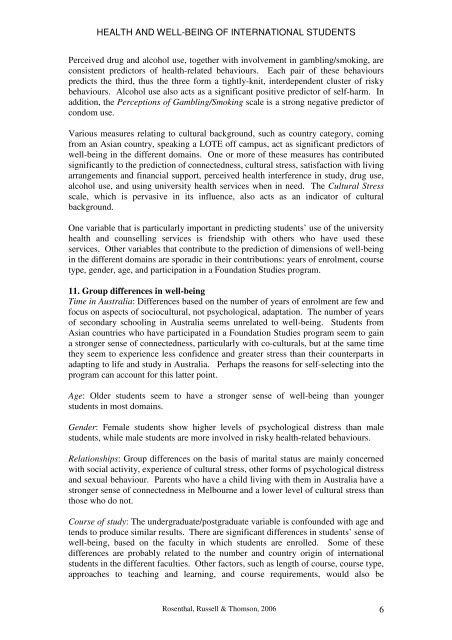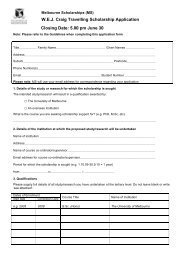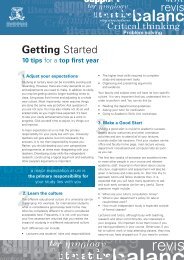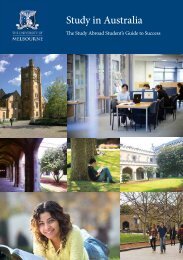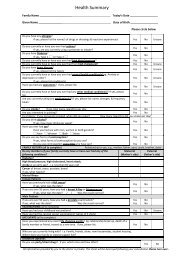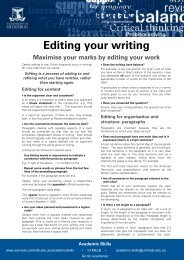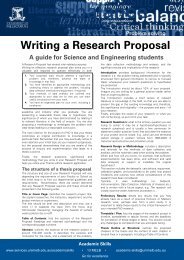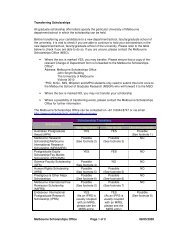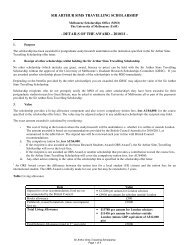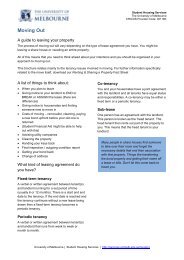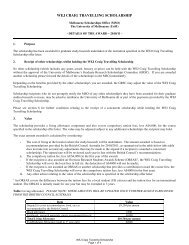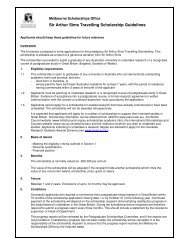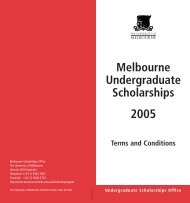a growing experience - Student Services - University of Melbourne
a growing experience - Student Services - University of Melbourne
a growing experience - Student Services - University of Melbourne
Create successful ePaper yourself
Turn your PDF publications into a flip-book with our unique Google optimized e-Paper software.
HEALTH AND WELL-BEING OF INTERNATIONAL STUDENTSPerceived drug and alcohol use, together with involvement in gambling/smoking, areconsistent predictors <strong>of</strong> health-related behaviours. Each pair <strong>of</strong> these behaviourspredicts the third, thus the three form a tightly-knit, interdependent cluster <strong>of</strong> riskybehaviours. Alcohol use also acts as a significant positive predictor <strong>of</strong> self-harm. Inaddition, the Perceptions <strong>of</strong> Gambling/Smoking scale is a strong negative predictor <strong>of</strong>condom use.Various measures relating to cultural background, such as country category, comingfrom an Asian country, speaking a LOTE <strong>of</strong>f campus, act as significant predictors <strong>of</strong>well-being in the different domains. One or more <strong>of</strong> these measures has contributedsignificantly to the prediction <strong>of</strong> connectedness, cultural stress, satisfaction with livingarrangements and financial support, perceived health interference in study, drug use,alcohol use, and using university health services when in need. The Cultural Stressscale, which is pervasive in its influence, also acts as an indicator <strong>of</strong> culturalbackground.One variable that is particularly important in predicting students’ use <strong>of</strong> the universityhealth and counselling services is friendship with others who have used theseservices. Other variables that contribute to the prediction <strong>of</strong> dimensions <strong>of</strong> well-beingin the different domains are sporadic in their contributions: years <strong>of</strong> enrolment, coursetype, gender, age, and participation in a Foundation Studies program.11. Group differences in well-beingTime in Australia: Differences based on the number <strong>of</strong> years <strong>of</strong> enrolment are few andfocus on aspects <strong>of</strong> sociocultural, not psychological, adaptation. The number <strong>of</strong> years<strong>of</strong> secondary schooling in Australia seems unrelated to well-being. <strong>Student</strong>s fromAsian countries who have participated in a Foundation Studies program seem to gaina stronger sense <strong>of</strong> connectedness, particularly with co-culturals, but at the same timethey seem to <strong>experience</strong> less confidence and greater stress than their counterparts inadapting to life and study in Australia. Perhaps the reasons for self-selecting into theprogram can account for this latter point.Age: Older students seem to have a stronger sense <strong>of</strong> well-being than youngerstudents in most domains.Gender: Female students show higher levels <strong>of</strong> psychological distress than malestudents, while male students are more involved in risky health-related behaviours.Relationships: Group differences on the basis <strong>of</strong> marital status are mainly concernedwith social activity, <strong>experience</strong> <strong>of</strong> cultural stress, other forms <strong>of</strong> psychological distressand sexual behaviour. Parents who have a child living with them in Australia have astronger sense <strong>of</strong> connectedness in <strong>Melbourne</strong> and a lower level <strong>of</strong> cultural stress thanthose who do not.Course <strong>of</strong> study: The undergraduate/postgraduate variable is confounded with age andtends to produce similar results. There are significant differences in students’ sense <strong>of</strong>well-being, based on the faculty in which students are enrolled. Some <strong>of</strong> thesedifferences are probably related to the number and country origin <strong>of</strong> internationalstudents in the different faculties. Other factors, such as length <strong>of</strong> course, course type,approaches to teaching and learning, and course requirements, would also beRosenthal, Russell & Thomson, 2006 6


